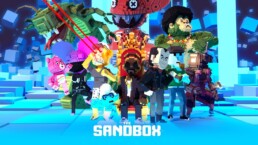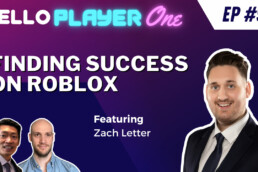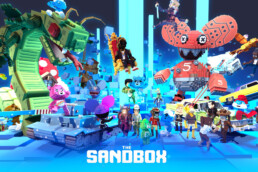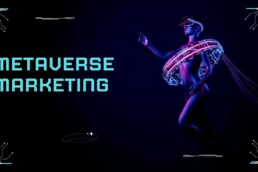In my Zoom calls with projects and brands looking to build in the metaverse, I’ve been asked over and over what I think about Sandbox vs other metaverses such as DCL and CryptoVoxels.
Since I’ve found myself repeating the same things over, I decided to write out the three main points on why our team focuses only building in The Sandbox.
Here’s the TL;DR:
- The team behind The Sandbox Metaverse has a long track record of shipping successful games. The Sandbox is actually the 3rd iteration of the Sandbox franchise. The previous Sandbox mobile games have done a combined ~50 million downloads.
- The Sandbox game is a perfect combination of both Roblox and Minecraft, the two most popular games with kids and young adults.
- Brands and projects want to create entire interactive worlds, not just a single building in the metaverse.
Team has a long track record of delivering products
The two founders, Sebastien and Arthur have founded previous companies before. One of them is Pixowl, which still exists and is a mobile games studio.
Pixowl published many games, including known IPs such as Garfield, Goosebumps, Adams Family and Peanuts. They’ve also published several called The Sandbox (not a coincidence). This Sandbox mobile game lets players create their own content, whether it’s some kind of pixel art or a mini-game and publish it to a gallery where other players can play. Sound familiar?
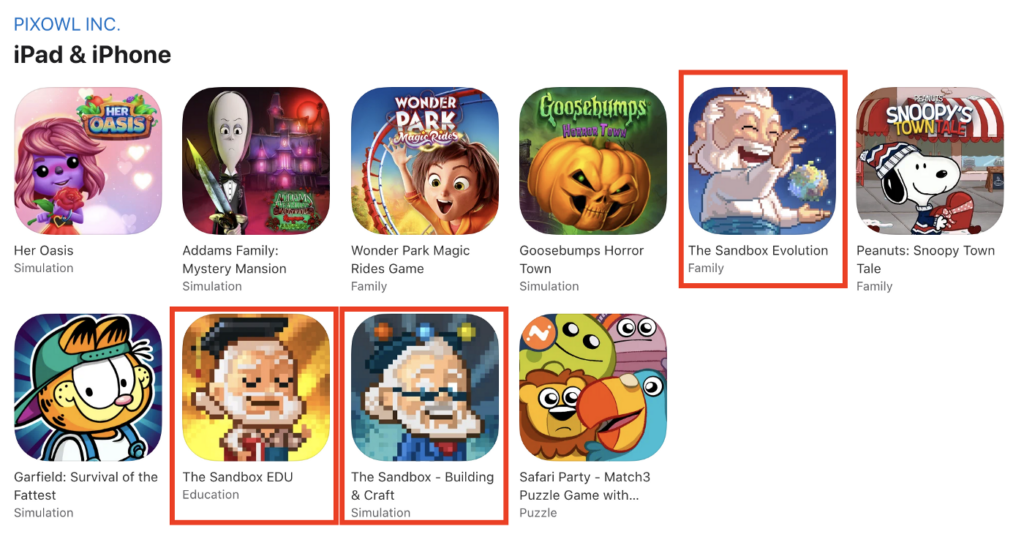 The Sandbox franchise mobile games
The Sandbox franchise mobile games
Below is a table from AppAnnie, a mobile analytics tool which estimates the number of downloads The Sandbox mobile games have had since their release. This includes both iOS and Google. They conservatively estimate the total to be 30 million downloads worldwide but I believe the real number is closer to 50 million downloads.
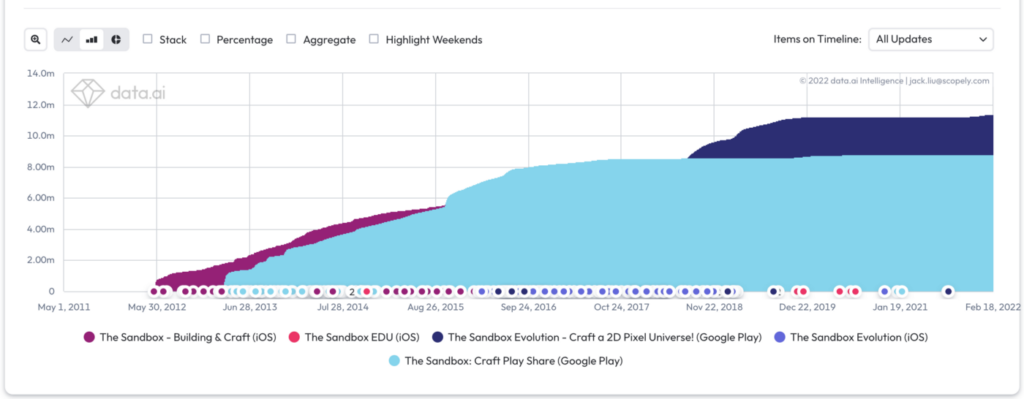 Cumulative downloads for each mobile game under The Sandbox franchise
Cumulative downloads for each mobile game under The Sandbox franchise
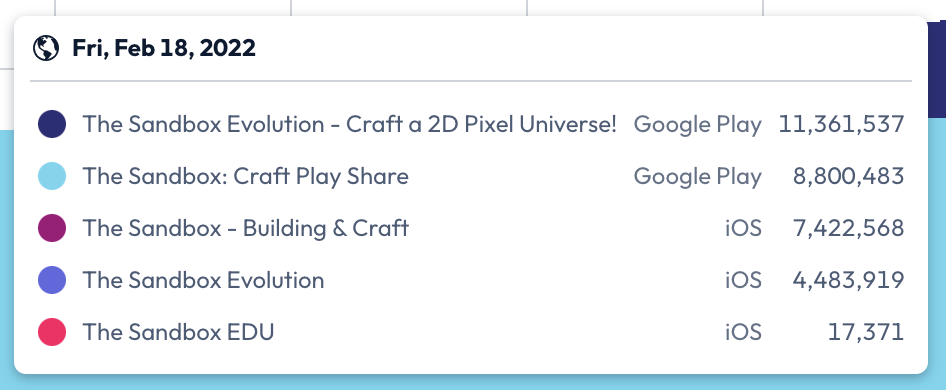 AppAnnie estimate for worldwide downloads of all The Sandbox mobile games
AppAnnie estimate for worldwide downloads of all The Sandbox mobile games
All you need to know is… that’s A LOT DOWNLOADS.
In essence, I’m betting on the people that’s creating the product.
The Sandbox game is the perfect combination of Minecraft and Roblox
Minecraft and Roblox are arguably the two most popular games for kids, with Fortnite being third.
Roblox and Minecraft seem like similar games but quite different under the hood. There are a few ways to play Minecraft, but the two main ones are 1) building things aka virtual Legos and 2) surviving a world full of enemies.
The building aspect is a huge part of Minecraft, and you can easily find YouTube videos showcasing building timelapses that have millions of views. As such, Minecraft tends to attract players who like to construct buildings and structures.
Roblox games, on the other hand, are all user-generated. It’s in essence a game-design engine and platform. You don’t see many Roblox building timelapses on YouTube. So instead, the players it attracts tend to be ones who want to create games, fun experiences.
The Sandbox game is a combination of both these things. There’s the block construction aspect. There’s the game design aspect. And there’s even one more – voxel asset creation. This attracts gamers who are also artists. So now, we have The Sandbox, which through its 3 main gameplay mechanics will attract the next generation of builders, artists and game designers.
Sandbox could be the most popular game in the future, but I also know if that were to happen, it’s going to take quite a while and there’ll be many roadblocks. But a 5-year horizon is feasible.
Brands want to build experiences, not just buildings in the metaverse
Brands entering the metaverse is an entire discussion on its own and won’t be covered in depth here. But we’re starting to see more and more brands create interactive experiences inside games.
There’s Vans World and Nikeland inside Roblox. There’s Adidas and Warner Music buying land in The Sandbox. You don’t just see brands creating single buildings. You see complete experiences.
Why are brands doing this?
Ultimately, brands want to sell their products but their timeframe for recouping the dollars spent on advertising is much much longer. A small e-commerce business that runs a Facebook ad might expect to recoup the ad dollars within 30–60 days. A brand that spends ad dollars is looking to recoup those same dollars 5–10 years later.
Brands are looking to buy mindshare in a younger demographic so that when they grow up and have disposable income, they will remember a brand and its products.
There’s many ways to buy mindshare- television ads, website banner ads, Facebook ads, etc. The best is creating an interactive experience, like a game that you and your friends can enjoy. We still talk about 16-bit Nintendo games but we can hardly remember Superbowl commercials from a year ago.
And by building inside popular game worlds, brands don’t have to spend additional dollars to drive users to that experience. That’s why we see brand integrations in Fortnite, Roblox and previously Minecraft.
So if you’re a brand that wants to build an interactive experience, which of the metaverses do you look into?
Well, a single 1×1 parcel of LAND in The Sandbox is about 10–15x bigger than the average parcel in DCL and CryptoVoxels. So for a brand looking to build something other than a single building in DCL or CryptoVoxels, they’re looking at $300–500k for just the land. Then add on an equivalent amount for development. In total, a brand could be looking at around $500k on the lower end to build out an interactive world inside DCL and CryptoVoxels. They can do that for about $50k in the Sandbox, 1/10th the cost.
Brands have money, but they also need to mitigate risk in the wild wild west of the metaverse.
Finally, ask yourself this: “if DCL and CryptoVoxels are already live, why didn’t Adidas or Warner Music buy a plot of land there?”
Here’s one more reason why I’m bullish for Sandbox:
They have significant funding (raising $93M in their latest series B) that will give them room to try things and “fail fast”. Do I believe they will create something 100% according to their vision and on-time? Probably not. But having a financial war chest allows a company to pivot if needed, to build the right features to achieve product-market fit, and to not die.
The future will be multi-verse
There’ll be hundreds of metaverses, just like there are hundreds of social media sites today. But there’ll only be a handful of metaverses that we go to everyday.
Metaverses are the next iteration of social media sites and we’ll have a specific use case for each one. In web 2.0, we use Facebook to connect with our existing friends, Twitter to get update on news or to talk about Crypto, and YouTube to learn a specific topic.
We’ll do the same in the future with the metaverses we choose to visit.
Get more insights like this on the business and marketing of the metaverse delivered to your inbox. We’ll never spam you, ever.
Jack Liu
Digital marketing entrepreneur with a background in engineering, paid advertising, and product development. Founder of Tentango.
Related Posts
June 14, 2023
How To Successfully Launch Games on Roblox, with Zach Letter of Wonder Works
How can developers successfully launch games on Roblox? In my recent…
May 20, 2023
Branding Success: Guaranteed Engagement in The Sandbox
The Sandbox Metaverse is a really interesting opportunity for branded…
March 7, 2023
Metaverse Marketing – The Emerging Practice
As the digital world continues to evolve, businesses need to stay ahead of the…
